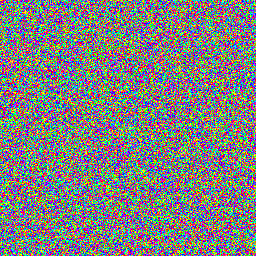Wikipedia:Featured picture candidates/Cyclic cellular automaton
Cyclic cellular automaton
Voting period is over. Please don't add any new votes. Voting period ends on 23 Feb 2021 at 17:46:59 (UTC)

- Reason
- This 25 second animation enhances the article, it helps readers understand the concept by adding an interesting visualization of the textual descriptions. It also meets: "being eye-catching to the point where users will want to read its accompanying article", as stated on top of this page.
- Articles in which this image appears
- Cyclic cellular automaton
- FP category for this image
- Wikipedia:Featured pictures/Sciences/Mathematics
- Creator
- Illiteration
- Support as nominator – Bammesk (talk) 17:46, 13 February 2021 (UTC)
- Support. Exhibits the main qualitative features of its topic (the changes in phase from randomness, to patches of color, to spirals, to the fastest spirals winning out over the slower ones). It's not the lead image of its article (a static image of a 1d cca) but still features prominently and provides significant information different from what's in the lead. And, importantly for FP on a technical topic, it's eye-catching. This tends to lead to FPs that are more focused around visual topics like fractals and cellular automata and less around important mathematics (much like our FPs in biology are focused on charismatic fauna and less on important theoretical aspects of biology), but I think cyclic CAs are still significant enough to bring the necessary EV. —David Eppstein (talk) 19:23, 13 February 2021 (UTC)
- Comment The final cycle goes on too long. --Janke | Talk 12:49, 14 February 2021 (UTC)
- It doesn't really stabilize into a cycle (it's somewhat similar to a moiré pattern). It's necessary to show the ongoing variations, for example new vertical ridges develop at the bottom-right and then at the bottom-left over the last 10 seconds. Bammesk (talk) 16:40, 14 February 2021 (UTC)
- Comment – Yikes! Let me out of here! – Sca (talk) 14:18, 14 February 2021 (UTC)
- This horrified reaction to even the most eye-catching and visually appealing and not-very-technical of mathematics images, and the reaction below that we must compromise the mathematical meaning of the image to make it even more eye-catching, is not making me optimistic about the ability of FPC to cover anything more than cute fuzzy animals and Kodak-spot tourist viewpoints. Is that really what we want when we clamor that en-FPC is different than commons-FPC because encyclopedic value? —David Eppstein (talk) 20:00, 21 February 2021 (UTC)
- I agree. We are here to pick the best images, meaning the best in the context of enhancing an article. We aren't here to pick eye-pleasing images. FP criteria says: "A featured picture is not always required to be aesthetically pleasing". In evaluating noms like the one here, a large measure of what is (or isn't) best has to do with the consensus of article editors (i.e. the choices they have made and article stability). The second half of this animation relates to the article text, which says: "The third stage ... The demons with shorter cycles consume demons with longer cycles". Looking at other FPs in the math category, this image may pass on renomination. Bammesk (talk) 03:22, 23 February 2021 (UTC)
- Comment Fine as a thumbnail but not an animation on an article proper (saturated colours are very distracting). Also agree that the final cycle is too long (developing ridges not obvious unless pointed out). cmɢʟee⎆τaʟκ 01:45, 16 February 2021 (UTC)
- It's more important for the topic that we show the full process of changes, including the last part that looks slower, than that we avoid boring viewers with attention spans of a few seconds. —David Eppstein (talk) 18:41, 16 February 2021 (UTC)
- The more obvious development is the slow disappearance of the very first vortex (at middle-left). There is a shorter version of this animation: here. I agree with the article editors that the longer version (the nom version) is the more appropriate one to use. The simulation starts with noise, and the longer term instability (albeit not obvious, but a consequence of the initial noise) is a relevant part of the animation. Bammesk (talk) 02:33, 17 February 2021 (UTC)
Not Promoted --Armbrust The Homunculus 23:11, 23 February 2021 (UTC)
- Nomination didn’t reach the necessary quorum for promotion. Armbrust The Homunculus 23:11, 23 February 2021 (UTC)
